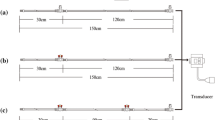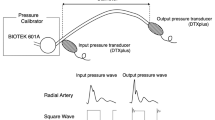Abstract
Two types of Planecta™ ports are commonly used as sampling ports in blood pressure transducer kits: a flat-type port (FTP) and a port with a three-way stopcock (PTS). Recently, a new type of three-way stopcock (Marvelous™) has been released as a Planecta™ counterpart, but its effects on the frequency characteristics and reliability of blood pressure monitoring have not been investigated. We assessed the influence of the Marvelous™ stopcock on the frequency characteristics of the pressure transducer kit. The basic pressure transducer kit, DT4812J, was modified by replacing one or two of the original three-way stopcocks with Marvelous™ stopcocks. The frequency characteristics (i.e., natural frequency and damping coefficient) of each kit were determined using wave parameter analysis software, and subsequently evaluated on a Gardner chart. Replacement of the original blood pressure transducer kit stopcocks with Marvelous™ stopcocks decreased the natural frequency (48.3 Hz) to 46.3 Hz or 44.8 Hz, respectively; the damping coefficient was not significantly changed. Plotting the data on a Gardner chart revealed that the changes fell within the adequate dynamic response region, indicating they were within the allowable range. Insertion of Marvelous™ stopcocks slightly affects the natural frequency of the pressure transducer kit, similar to inserting a PTS. The results indicate that the Marvelous™ stopcock is useful for accurate monitoring of arterial blood pressure, and may be recommended when insertion of two or more closed-loop blood sampling systems is necessary.











Similar content being viewed by others
References
Gravenstein SJ, Paulus AD. Clinical monitoring practice. 2nd ed. Philadelphia: JS Lippincott Company; 1987.
William TM, Jan MH, John AF. Quick guide to cardiopulmonary care. 2nd ed. Irvine: Edwards Life Sciences; 2009.
Fujiwara S, Kawakubo Y, Mori S, Tachihara K, Toyoguchi I, Yokoyama T. Effect of Planecta and ROSE™ on the frequency characteristics of blood pressure-transducer kits. J Clin Monit Comput. 2014;29:681–9. doi:10.1007/s10877-014-9650-y.
Fujiwara S, Tachihara K, Mori S, Ouchi K, Yokoe C, Imaizumi U, Morimoto Y, Miki Y, Toyoguchi I, Yoshida KI, Yokoyama T. Effect of using a Planecta™ port with a three-way stopcock on the natural frequency of blood pressure transducer kits. J Clin Monit Comput (Epub ahead of print). 2015. doi:10.1007/s10877-015-9795-3.
Crow S, Conrad SA, Chaney-Rowell C, King JW. Microbial contamination of arterial infusions used for hemodynamic monitoring: a randomized trial of contamination with sampling through conventional stopcocks versus a novel closed system. Infect Control Hosp Epidemiol. 1989;10:557–61. doi:10.2307/30144237.
Watanabe H, Yagi S, Namiki A. Recommendation of a clinical impulse response analysis for catheter calibration-dumping coefficient and natural frequency are incomplete parameters for clinical evaluation. J Clin Monit Comput 2006;20:37–42. doi:10.1007/s10877-005-9008-6.
Gardner RM. Direct blood pressure measurement–dynamic response requirements. Anesthesiology 1981;54:227–36. doi:10.1097/00000542-198103000-00010.
Todorovic M, Jensen EW, Thøgersen C. Evaluation of dynamic performance in liquid-filled catheter systems for measuring invasive blood pressure. Int J Clin Monit Comput. 1996;13:173–8. doi:10.1023/A:1016903508976.
Romagnoli S, Romano SM, Bevilacqua S, Lazzeri C, Gensini GF, Pratesi C, Quattrone D, Dini D, De Gaudio AR. Dynamic response of liquid-filled catheter systems for measurement of blood pressure: precision of measurements and reliability of the pressure recording analytical method with different disposable systems. J Crit Care. 2011;26:415–22. doi:10.1016/j.jcrc.2010.08.010.
Gersh BJ. Measurement of intravascular pressure. In: Prys-Roberts C, editor. The circulation in anaesthesia: applied physiology and pharmacology. Oxford: Blackwell Scientific Publications; 1980. p. 511–8.
Watanabe H. A theory and practice for the accurate arterial blood pressure measurement. Life Support Anesth. 2007;14:630–634.
Fujiwara S, Mori S, Tachihara K, Yamamoto T, Yokoe C, Imaizumi U, Morimoto Y, Miki Y, Toyoguchi I, Yoshida KI, Yokoyama T. Frequency characteristics of pressure transducer kits with inserted pressure-resistant extension tubes. J Clin Monit Comput (Epub ahead of print). 2016. doi:10.1007/s10877-016-9854-4.
Runciman WB, Rutten AJ, Ilsley AH. An evaluation of blood pressure measurement. Anaesth Intensive Care. 1981;9:314–25.
Acknowledgements
We thank Editage for English language editing. The authors would also like to thank Masashi Kochaku from Nihon Kohden for providing to information of medical monitor filters.
Author information
Authors and Affiliations
Corresponding author
Ethics declarations
Conflict of interest
Izumi Toyoguchi is employed by Argon Medical Devices Japan, the Japanese branch of Argon Medical Devices, which provides Marvelous™. This work was supported by intradepartmental funds. No external financial support was obtained. The authors have no conflicts of interest to disclose.
Ethical approval
Not applicable.
Informed consent
Not applicable.
Rights and permissions
About this article
Cite this article
Fujiwara, S.J.L., Tachihara, K., Mori, S. et al. Influence of the marvelous™ three-way stopcock on the natural frequency and damping coefficient in blood pressure transducer kits. J Clin Monit Comput 32, 63–72 (2018). https://doi.org/10.1007/s10877-017-9979-0
Received:
Accepted:
Published:
Issue Date:
DOI: https://doi.org/10.1007/s10877-017-9979-0




